2012 PEUGEOT 4007 ECU
[x] Cancel search: ECUPage 83 of 236
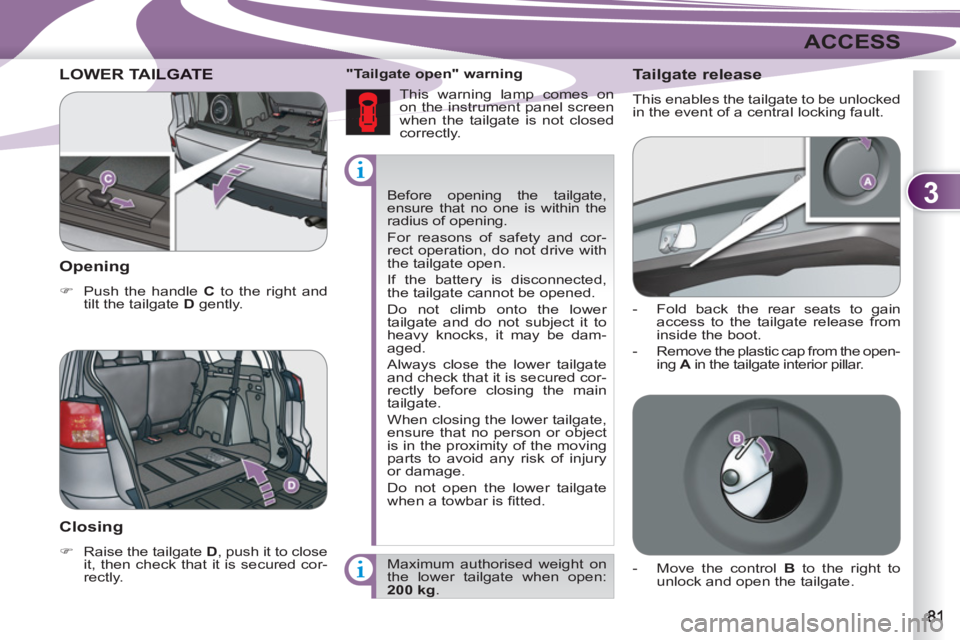
3
ACCESS
Before opening the tailgate,
ensure that no one is within the
radius of opening.
For reasons of safety and cor-
rect operation, do not drive with
the tailgate open.
If the battery is disconnected,
the tailgate cannot be opened.
Do not climb onto the lower
tailgate and do not subject it to
heavy knocks, it may be dam-
aged.
Always close the lower tailgate
and check that it is secured cor-
rectly before closing the main
tailgate.
When closing the lower tailgate,
ensure that no person or object
is in the proximity of the moving
parts to avoid any risk of injury
or damage.
Do not open the lower tailgate
when a towbar is fi tted.
"Tailgate open" warning
This warning lamp comes on
on the instrument panel screen
when the tailgate is not closed
correctly.
LOWER TAILLGATE
Opening
�)
Push the handle C
to the right and
tilt the tailgate D
gently.
Closing
�)
Raise the tailgate D
, push it to close
it, then check that it is secured cor-
rectly. Maximum authorised weight on
the lower tailgate when open:
200 kg
.
Tailgate release
This enables the tailgate to be unlocked
in the event of a central locking fault.
- Fold back the rear seats to gain
access to the tailgate release from
inside the boot.
- Remove the plastic cap from the open-
ing A
in the tailgate interior pillar.
- Move the control B
to the right to
unlock and open the tailgate.
Page 97 of 236
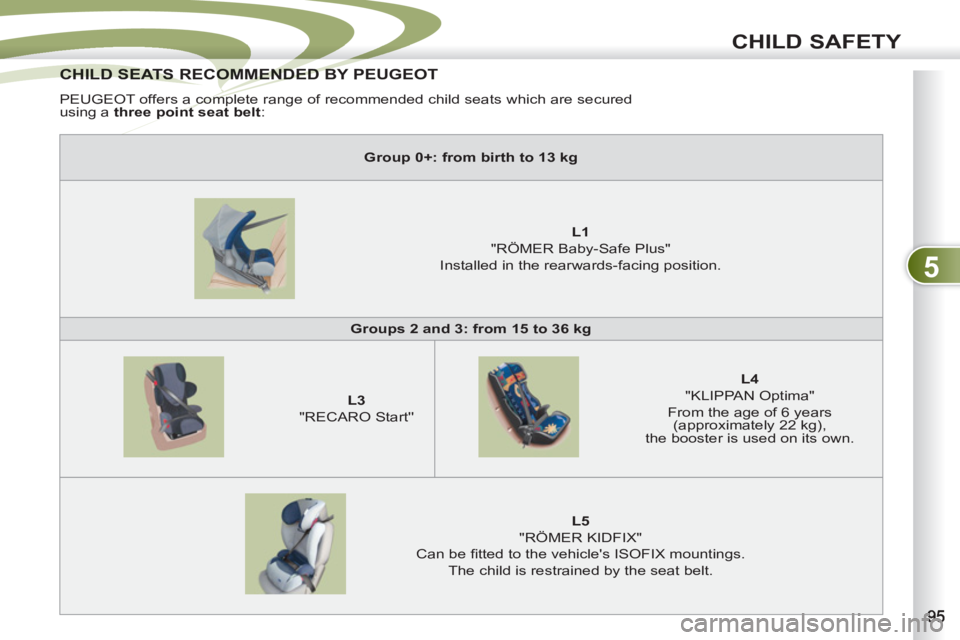
5
CHILD SAFETY
CHILD SEATS RECOMMENDED BY PEUGEOT CHILD SEATS RECOMMENDED B
PEUGEOT offers a complete range of recommended child seats which are secured
using a three point seat belt
:
Group 0+: from birth to 13 kg
L1
"RÖMER Baby-Safe Plus"
Installed in the rearwards-facing position.
Groups 2 and 3: from 15 to 36 kg
L3
"RECARO Start''
L4
"KLIPPAN Optima"
From the age of 6 years
(approximately 22 kg),
the booster is used on its own.
L5
"RÖMER KIDFIX"
Can be fi tted to the vehicle's ISOFIX mountings.
The child is restrained by the seat belt.
Page 99 of 236
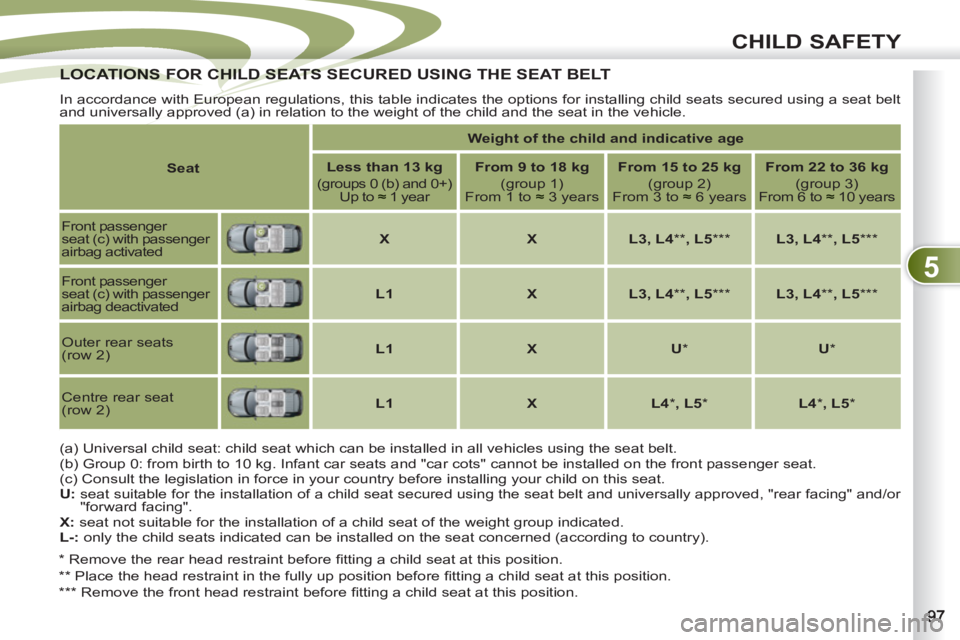
5
CHILD SAFETY
LOCATIONS FOR CHILD SEATS SECURED USING THE SEAT BELTLOCATIONS FOR CHILD SEATS S
In accordance with European regulations, this table indicates the options for installing child seats secured using a seat belt
and universally approved (a) in relation to the weight of the child and the seat in the vehicle.
(a) Universal child seat: child seat which can be installed in all vehicles using the seat belt.
(b) Group 0: from birth to 10 kg. Infant car seats and "car cots" cannot be installed on the front passenger seat.
(c) Consult the legislation in force in your country before installing your child on this seat.
U:
seat suitable for the installation of a child seat secured using the seat belt and universally approved, "rear facing" and/or
"forward facing".
X:
seat not suitable for the installation of a child seat of the weight group indicated.
L-:
only the child seats indicated can be installed on the seat concerned (according to country).
Seat
Weight of the child and indicative age
Less than 13 kg
(groups 0 (b) and 0+)
Up to
≈ 1 year
From 9 to 18 kg
(group 1)
From 1 to ≈ 3 years
From 15 to 25 kg
(group 2)
From 3 to ≈ 6 years
From
22 to 36 kg
(group 3)
From 6 to ≈ 10 years
Front passenger
seat (c) with passenger
airbag activated
X
X
L3, L4
**
, L5
***
L3, L4
**
, L5
***
Front passenger
seat (c) with passenger
airbag deactivated
L1
X
L3, L4
**
, L5
***
L3, L4
**
, L5
***
Outer rear seats
(row 2)
L1
X
U
*
U
*
Centre rear seat
(row 2)
L1
X
L4
*
,
L5
*
L4
*
, L5
*
*
Remove the rear head restraint before fi tting a child seat at this position.
**
Place the head restraint in the fully up position before fi tting a child seat at this position.
***
Remove the front head restraint before fi tting a child seat at this position.
Page 100 of 236
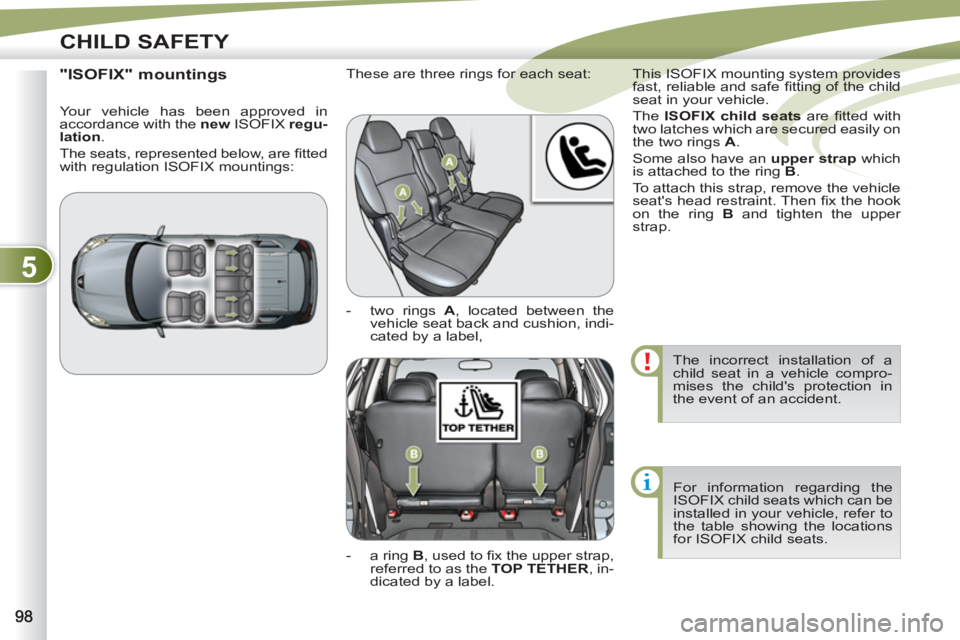
5
CHILD SAFETY
The incorrect installation of a
child seat in a vehicle compro-
mises the child's protection in
the event of an accident.
For information regarding the
ISOFIX child seats which can be
installed in your vehicle, refer to
the table showing the locations
for ISOFIX child seats.
"ISOFIX" mountings
These are three rings for each seat:
- two rings A
, located between the
vehicle seat back and cushion, indi-
cated by a label,
- a ring B
, used to fi x the upper strap,
referred to as the TOP TETHER
, in-
dicated by a label. This ISOFIX mounting system provides
fast, reliable and safe fi tting of the child
seat in your vehicle.
The ISOFIX child seats
are fi tted with
two latches which are secured easily on
the two rings A
.
Some also have an upper strap
which
is attached to the ring B
.
To attach this strap, remove the vehicle
seat's head restraint. Then fi x the hook
on the ring B
and tighten the upper
strap. Your vehicle has been approved in
accordance with the new
ISOFIX regu-
lation
.
The seats, represented below, are fi tted
with regulation ISOFIX mountings:
Page 101 of 236
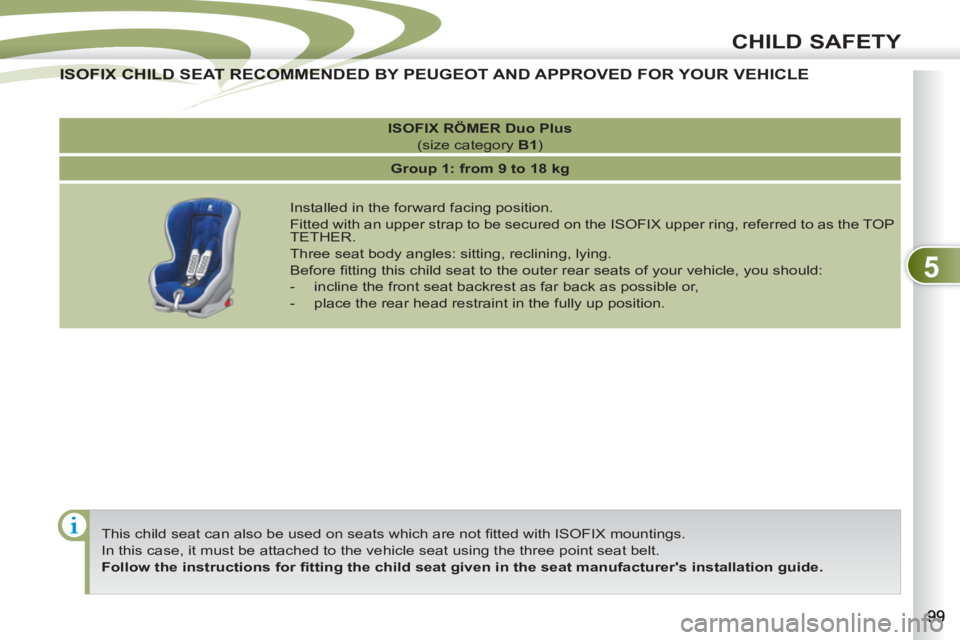
5
CHILD SAFETY
This child seat can also be used on seats which are not fi tted with ISOFIX mountings.
In this case, it must be attached to the vehicle seat using the three point seat belt.
Follow the instructions for fi tting the child seat given in the seat manufacturer's installation guide.
ISOFIX
RÖMER Duo Plus
(size category B1
)
Group 1: from 9 to 18 kg
Installed in the forward facing position.
Fitted with an upper strap to be secured on the ISOFIX upper ring, referred to as the TOP
TETHER.
Three seat body angles: sitting, reclining, lying.
Before fi tting this child seat to the outer rear seats of your vehicle, you should:
- incline the front seat backrest as far back as possible or,
- place the rear head restraint in the fully up position.
ISOFIX CHILD SEAT RECOMMENDED BY PEUGEOT AND APPROVED FOR YOUR VEHICLE
ISOFIX CHILD SEAT RECOMMEN
Page 102 of 236
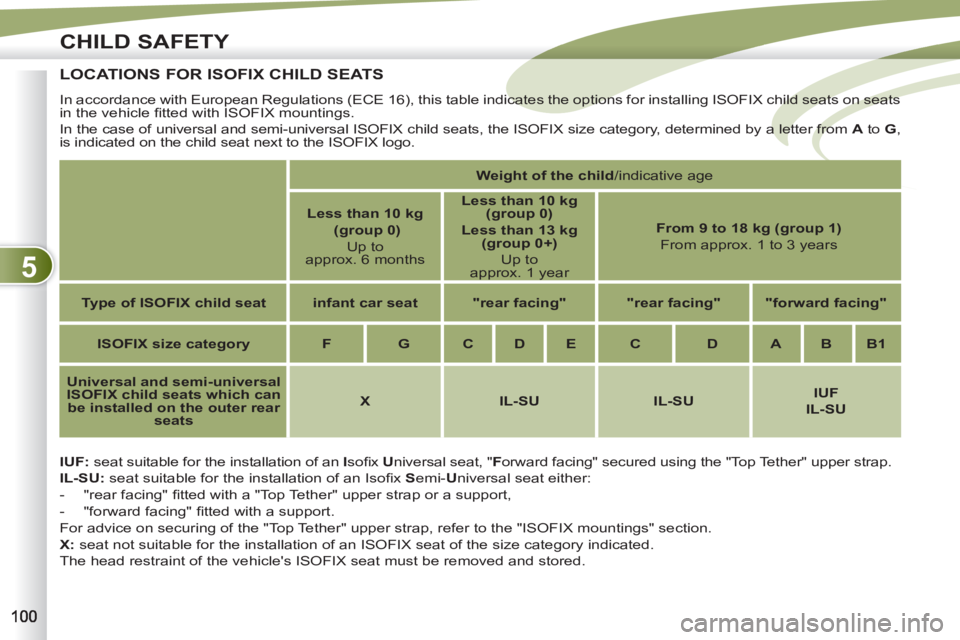
5
CHILD SAFETY
LOCATIONS FOR ISOFIX CHILD SEATS
IUF:
seat suitable for the installation of an I
sofi x U
niversal seat, " F
orward facing" secured using the "Top Tether" upper strap.
IL-SU:
seat suitable for the installation of an Isofi x S
emi- U
niversal seat either:
- "rear facing" fi tted with a "Top Tether" upper strap or a support,
- "forward facing" fi tted with a support.
For advice on securing of the "Top Tether" upper strap, refer to the "ISOFIX mountings" section.
X:
seat not suitable for the installation of an ISOFIX seat of the size category indicated.
The head restraint of the vehicle's ISOFIX seat must be removed and stored. In accordance with European Regulations (ECE 16), this table indicates the options for installing ISOFIX child seats on seats
in the vehicle fi tted with ISOFIX mountings.
In the case of universal and semi-universal ISOFIX child seats, the ISOFIX size category, determined by a letter from A
to G
,
is indicated on the child seat next to the ISOFIX logo.
Weight of the child
/indicative age
Less than 10 kg
(group 0)
Up to
approx. 6 months
Less than 10 kg
(group 0)
Less than
13 kg
(group 0+)
Up to
approx. 1 year
From 9 to 18 kg (group 1)
From approx. 1 to 3 years
Type of ISOFIX child seat
infant car seat
"rear facing"
"rear facing"
"forward facing"
ISOFIX size category
F
G
C
D
E
C
D
A
B
B1
Universal and semi-universal
ISOFIX child seats which can
be installed on the outer rear
seats
X
IL-SU
IL-SU
IUF
IL-SU
Page 103 of 236
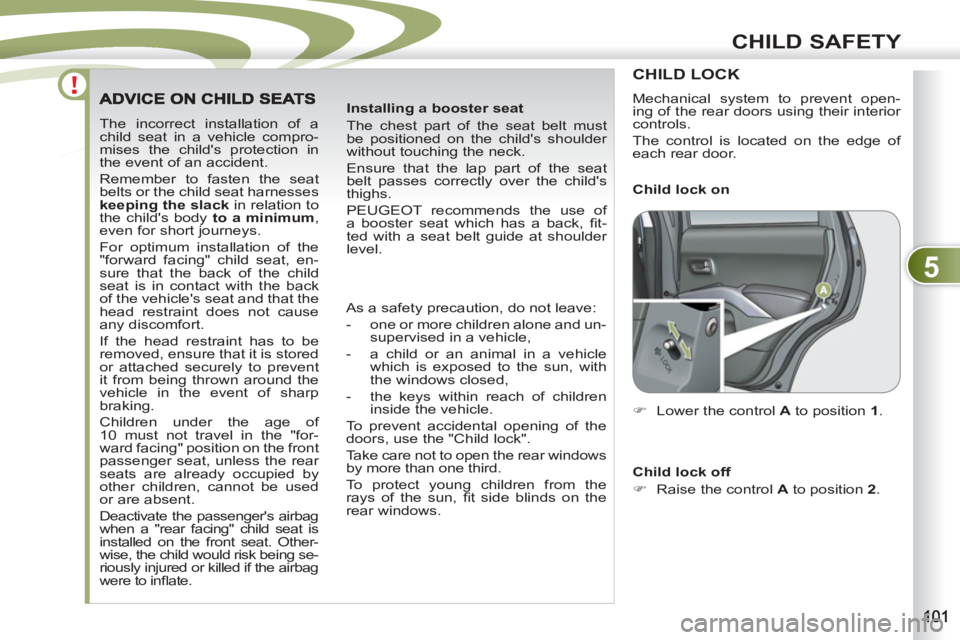
5
CHILD SAFETY
The incorrect installation of a
child seat in a vehicle compro-
mises the child's protection in
the event of an accident.
Remember to fasten the seat
belts or the child seat harnesses
keeping the slack
in relation to
the child's body to a minimum
,
even for short journeys.
For optimum installation of the
"forward facing" child seat, en-
sure that the back of the child
seat is in contact with the back
of the vehicle's seat and that the
head restraint does not cause
any discomfort.
If the head restraint has to be
removed, ensure that it is stored
or attached securely to prevent
it from being thrown around the
vehicle in the event of sharp
braking.
Children under the age of
10 must not travel in the "for-
ward facing" position on the front
passenger seat, unless the rear
seats are already occupied by
other children, cannot be used
or are absent.
Deactivate the passenger's airbag
when a "rear facing" child seat is
installed on the front seat. Other-
wise, the child would risk being se-
riously injured or killed if the airbag
were to infl ate.
Installing a booster seat
The chest part of the seat belt must
be positioned on the child's shoulder
without touching the neck.
Ensure that the lap part of the seat
belt passes correctly over the child's
thighs.
PEUGEOT recommends the use of
a booster seat which has a back, fi t-
ted with a seat belt guide at shoulder
level.
As a safety precaution, do not leave:
- one or more children alone and un-
supervised in a vehicle,
- a child or an animal in a vehicle
which is exposed to the sun, with
the windows closed,
- the keys within reach of children
inside the vehicle.
To prevent accidental opening of the
doors, use the "Child lock".
Take care not to open the rear windows
by more than one third.
To protect young children from the
rays of the sun, fi t side blinds on the
rear windows.
CHILD LOCK
�)
Lower the control A
to position 1
.
Child lock on
Child lock off
�)
Raise the control A
to position 2
.
Mechanical system to prevent open-
ing of the rear doors using their interior
controls.
The control is located on the edge of
each rear door.
Page 109 of 236
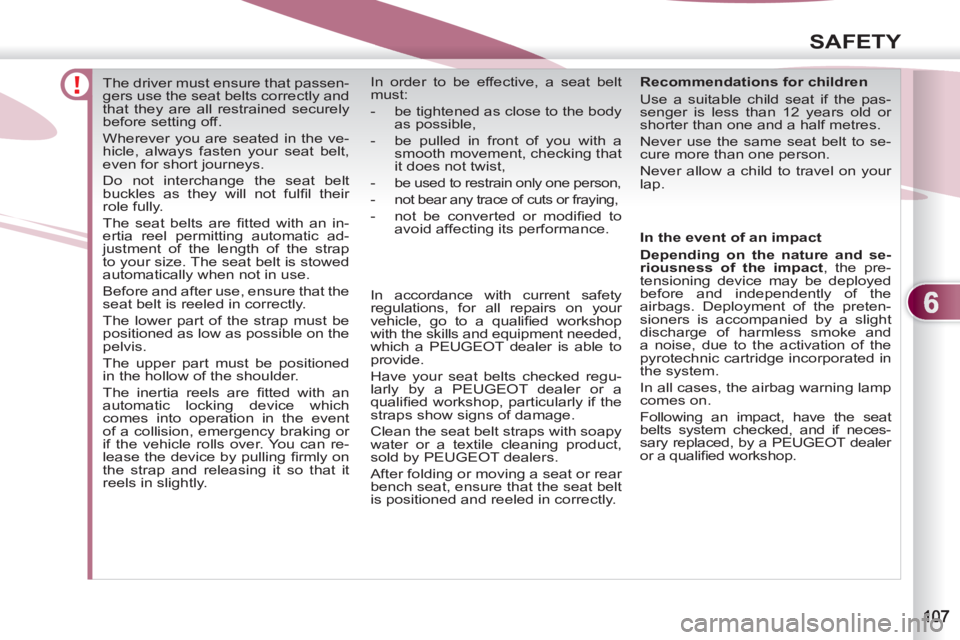
6
SAFETY
The driver must ensure that passen-
gers use the seat belts correctly and
that they are all restrained securely
before setting off.
Wherever you are seated in the ve-
hicle, always fasten your seat belt,
even for short journeys.
Do not interchange the seat belt
buckles as they will not fulfi l their
role fully.
The seat belts are fi tted with an in-
ertia reel permitting automatic ad-
justment of the length of the strap
to your size. The seat belt is stowed
automatically when not in use.
Before and after use, ensure that the
seat belt is reeled in correctly.
The lower part of the strap must be
positioned as low as possible on the
pelvis.
The upper part must be positioned
in the hollow of the shoulder.
The inertia reels are fi tted with an
automatic locking device which
comes into operation in the event
of a collision, emergency braking or
if the vehicle rolls over. You can re-
lease the device by pulling fi rmly on
the strap and releasing it so that it
reels in slightly.
Recommendations for children
Use a suitable child seat if the pas-
senger is less than 12 years old or
shorter than one and a half metres.
Never use the same seat belt to se-
cure more than one person.
Never allow a child to travel on your
lap. In order to be effective, a seat belt
must:
- be tightened as close to the body
as possible,
- be pulled in front of you with a
smooth movement, checking that
it does not twist,
-
be used to restrain only one person,
- not bear any trace of cuts or fraying,
- not be converted or modifi ed to
avoid affecting its performance.
In accordance with current safety
regulations, for all repairs on your
vehicle, go to a qualifi ed workshop
with the skills and equipment needed,
which a PEUGEOT dealer is able to
provide.
Have your seat belts checked regu-
larly by a PEUGEOT dealer or a
qualifi ed workshop, particularly if the
straps show signs of damage.
Clean the seat belt straps with soapy
water or a textile cleaning product,
sold by PEUGEOT dealers.
After folding or moving a seat or rear
bench seat, ensure that the seat belt
is positioned and reeled in correctly.
In the event of an impact
Depending on the nature and se-
riousness of the impact
, the pre-
tensioning device may be deployed
before and independently of the
airbags. Deployment of the preten-
sioners is accompanied by a slight
discharge of harmless smoke and
a noise, due to the activation of the
pyrotechnic cartridge incorporated in
the system.
In all cases, the airbag warning lamp
comes on.
Following an impact, have the seat
belts system checked, and if neces-
sary replaced, by a PEUGEOT dealer
or a qualifi ed workshop.